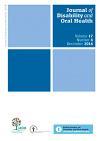Community Dental Health

- Cover Date:
- September 2012
- Print ISSN:
- 0265 539X
- Vol:
- 29
- Issue:
- 3
Oral hygiene education in adolescence based on the Precaution Adoption Process Model
Objective: The present study hypothesised that interventions based on the Precaution Adoption Process Model (PAPM) are more effective than the conventional approach in modifying oral hygiene behaviour in adolescents. Method: A stratified random sampling method was used with subject groups (classrooms) randomly allocated to a control or to one of intervention groups (conventional instruction or PAPM). Short-term and long-term results were assessed after 3 and 12 months. The study sample comprised 254 12-13 year olds whose plaque levels were assessed by two outcome measures, namely the Quantitative Plaque Percent Index and its derivative the Ratio of Plaque % Change. Results: Subject retention rate was 69%. The most substantial decrease in plaque scores was in the PAPM group (12% after 3 months, 18% after 12 months), while the smallest reduction was in the control group (4% after 3 months and 12% after 12 months). There was a trend of reduction in plaque levels (p<0.001) in all study groups from baseline to the 12 month follow-up. Conclusions: The intervention based on the Precaution Adoption Process Model was only slightly more effective in changing adolescent oral hygiene behaviour as compared to the conventional approach. The positive change in the control group was unexpected and needs further exploration.
Key words: dental plaque index, adolescent, oral hygiene, health behaviour, Precaution Adoption Process ModelMethods
The study was approved by the Bioethics Committee of the Ministry of Health. All 12-13-year-old adolescents from 3 randomly selected secondary schools were invited to participate in the study. Prior to the study, written informed consent was obtained from both the adolescents and their parents or guardians. To reduce possible measurement bias (Hawthorne Effect), all clinical examinations were performed at a time not announced in advance to the participants. A stratified random sampling method was used and 17 subject groups (classes) were randomly allocated either into a control or into one of the intervention groups (conventional instruction group or PAPM group). The short-term and long-term results were assessed after 3 and 12 months, respectively.
Correspondence to: J. Aleksejūnienė, Department of Oral Health Sciences, Faculty of Dentistry, The University of British Columbia, 2199 Wesbrook Mall, Vancouver, BC Canada V6T 1Z3. Email: jolanta@dentistry.ubc.ca
- Article Price
- £15.00
- Institution Article Price
- £
- Page Start
- 248
- Page End
- 251
- Authors
- V. BrukienÄ—
Articles from this issue
- Title
- Pg. Start
- Pg. End
- Editorial - Population based health and care: what does the new dental professional need to know?
- 194
- 194
- Dental Public Health in Action - The use of dental therapists as examiners in dental epidemiological surveys
- 195
- 197
- A service evaluation of patient pathways and care experiences of dentally anxious adult patients
- 198
- 202
- Assessment and validation of the oral impact on daily performance (OIDP) instrument among adults in Karnataka, South India
- 203
- 208
- High levels of periodontal disease among the older adult population in San Juan, Puerto Rico
- 224
- 228
